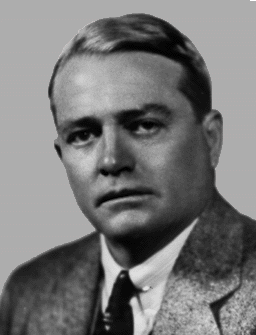
Charles Crawford
6/1/1951 - 7/31/1954
Charles Crawford was born on a farm in McLennan County, Texas,
on July 21, 1888. In 1909, he graduated from Oklahoma A&M with
a B.A. in chemistry. When he failed the Civil Service analyst exam,
he began work at the Agricultural Experiment Station where he worked
part time on state food and drug law enforcement problems, mainly
analytical work. In 1915, Crawford obtained his master's degree,
and again took the Civil Service analyst exam. This time he passed,
and in 1917, finally got the job he wanted as an assistant chemist
in the Bureau of Chemistry. After working as an analyst in the Chicago
and New Orleans stations, he was drafted by Walter Campbell for
administrative work in 1918, and never went back to the bench. In
1928, he became head of newly created Interstate Division.
Once a determination had been made by the New Deal Administration
that it would seek a new federal food and drug statute, Crawford
began to work on a legislative framework for the new law, and he
quickly became the FDA's principal representative with the members
of Congress and legislative advisers who drafted the 1938 Food,
Drug, and Cosmetic Act. Crawford exhibited a special talent for
legislative drafting, which even won him the respect of lawyers
expert in that field. He advised members of Congress on the intricacies
of food and drug problems and convinced them of the need for new
protective features. Following passage of the 1938 Act, he was appointed
FDA Technical Advisor, and assigned to the Office of the Chief of
the FDA. In 1942, he became Assistant Commissioner. Crawford devoted
most of his time from 1938-1944 formulating regulations and standards
under the new law. Crawford's wordsmithing became one of his greatest
lasting contributions. "He had an uncanny way of phrasing language
to cover loopholes in any statement that would require living up
to by those who were regulated," wrote one observer. "I
think that his great service to the whole food and drug movement
was getting statements into shape that could not be distorted or
circumvented."
In 1951, when Paul Dunbar announced his intention to retire, Crawford
was viewed the logical successor. In making the appointment, Oscar
Ewing noted that "food and drug law enforcement is a highly
specialized activity. Today, more than ever, the interest of the
American consumer requires that this work be kept in experienced
hands."
Under Crawford, the agency was forced to develop the scientific
expertise needed to understand and meet the challenges of the nuclear
age and the effects of radioactivity on foods and drugs. Crises
included massive cleanup activities following the Kansas City flood
of 1951, and the chloramphenicol investigation of 1952 which exposed
the risk of deadly aplastic anemia from the indiscriminate use of
the powerful antibiotic, and resulted in mandated revised drug labeling.
Crawford launched the agency's Grain Sanitation Program, the largest
compliance program in the history of the agency, designed to keep
flour and bakery products free of filth, and directed action against
nutritional and dietary quackery. Crawford was innovative and deliberate
in using education and information to reach important objectives.
Following a public relations nightmare over the establishment of
standards of identity for white bread, Crawford approved the appointment
of 16 part-time consumer consultants--one for each district.
After the Supreme Court overturned the agency's factory inspection
authority, resulting in a de facto reduction in the agency's abilities
to compel industry records, Crawford presided over a political debacle
which threatened to leave the agency's inspectional authority even
more emasculated. Although the problem was not adequately addressed
until the 1962 Drug Amendments were passed, questions about the
reach of the agency's authority drew increasing attention to its
lack of resources. In 1952, the agency had only 230 inspectors and
300 laboratory scientists. A cut in the 1953 appropriation from
$5,648,000 to $5,000,000 resulted in the agency's first and only
Reduction in Force, resulting in the loss of about one hundred employees.
By 1954, agency resources remained at the low level they had struck
in 1948, and the enforcement staff was the same as in 1940 despite
new industries, new food and drug technology, and new amendments.
Crawford met this challenge by adopting a bureaucratic tactic
popular in the Eisenhower administration. In a memo to Undersecretary
of Health, Education, and Welfare, Nelson A. Rockefeller dated September
1, 1953, Crawford suggested the appointment of an advisory committee
to look at the agency's resources relative to consumer demand. Five
months later, the First Citizen's Advisory Committee on the FDA
made one hundred recommendations, and concluded that "FDA has
insufficient funds, staff, and facilities to meet its essential
responsibility of protecting the public health." The committee
further anticipated that the agency would "require expansion
in personnel and facilities between and three and fourfold within
five to ten years." Following the Committee's report, HEW Secretary
Oveta Culp Hobby accepted Crawford's resignation. Three years after
retiring, Charles Crawford died of leukemia on September 15, 1957.